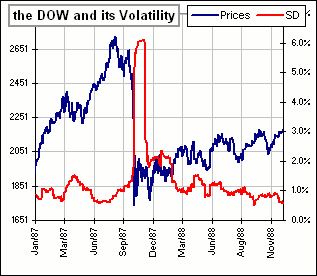| Volatility and the Market |
After writing the stuff on September and the Market, I was looking carefully at other correlations and found interesting comparisons between stock market prices and volatility (or Standard Deviation).
| For example, the crash of '87 shows HUGE volatility in October/87
(see Figure 1) and ...
>But you'd expect that, right?
>And?
>A picture is worth a thousand ... |  Figure 1 |

You can move that one month window and choose which correlation you'd like to know and you even get a regression line for that one-month window and ...
>And what am I supposed to do with the spreadsheet?
Click on the picture to download it ... and play! 
You can, for example, choose to Buy when the volatility exceeds 1.0% and Sell when it drops below 0.8%
(as in the picture, above).
In the example shown, although GE stock gained 5.8% over the period Sept/04 to Sept/06, your Portfolio would have gained 13.5% 
>And you'd recommend that strategy?
Huh? Me? Recommend? I just provide the toys ...